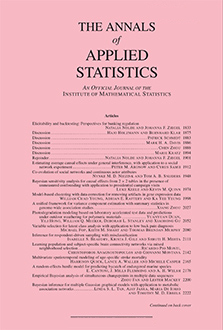Abstract
We study possible relations between Alzheimer’s disease progression and the structure of the connectome which is white matter connecting different regions of the brain. Regression models in covariates including age, gender and disease status for the extent of white matter connecting each pair of regions of the brain are proposed. Subject inhomogeneity is also incorporated in the model through random effects with an unknown distribution. As there is a large number of pairs of regions, we also adopt a dimension reduction technique through graphon (J. Combin. Theory Ser. B 96 (2006) 933–957) functions which reduces the functions of pairs of regions to functions of regions. The connecting graphon functions are considered unknown but the assumed smoothness allows putting priors of low complexity on these functions. We pursue a nonparametric Bayesian approach by assigning a Dirichlet process scale mixture of zero to mean normal prior on the distributions of the random effects and finite random series of tensor products of B-splines priors on the underlying graphon functions. We develop efficient Markov chain Monte Carlo techniques for drawing samples for the posterior distributions using Hamiltonian Monte Carlo (HMC). The proposed Bayesian method overwhelmingly outperforms a competing method based on ANCOVA models in the simulation setup. The proposed Bayesian approach is applied on a dataset of 100 subjects and 83 brain regions and key regions implicated in the changing connectome are identified.
Citation
Arkaprava Roy. Subhashis Ghosal. Jeffrey Prescott. Kingshuk Roy Choudhury. "Bayesian modeling of the structural connectome for studying Alzheimer’s disease." Ann. Appl. Stat. 13 (3) 1791 - 1816, September 2019. https://doi.org/10.1214/19-AOAS1257
Information





